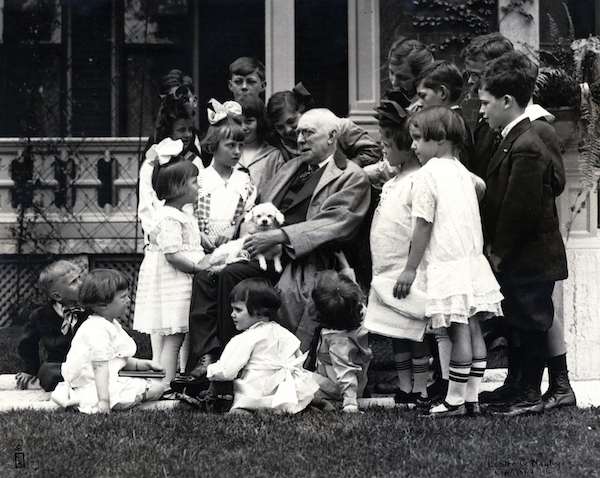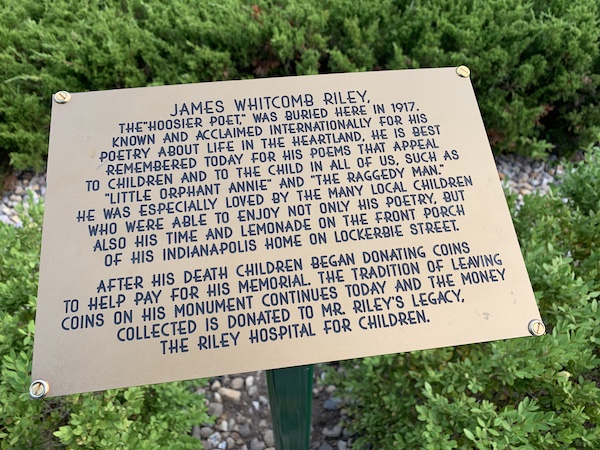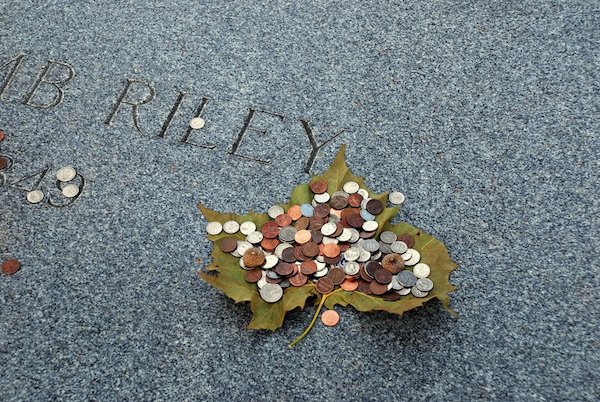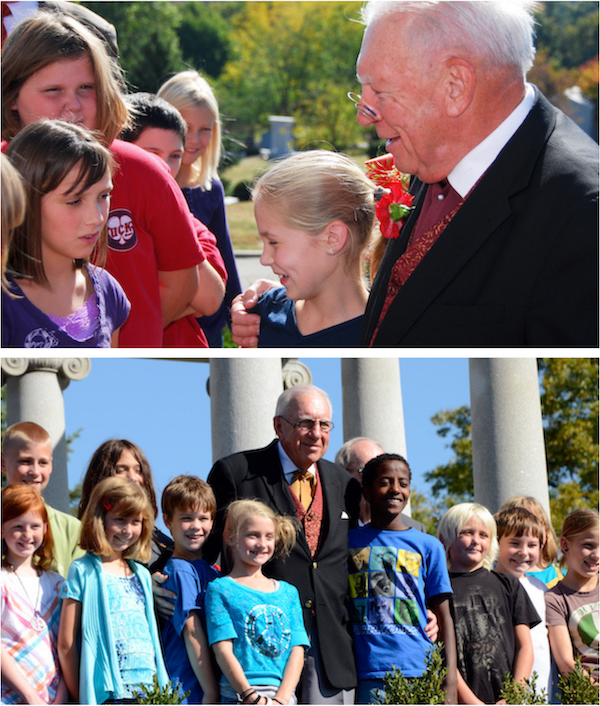James Whitcomb Riley
James Whitcomb Riley
(October 7, 1849-July 22, 1916)
“…the Hoosier Poet blew heart bubbles. He took by divine right his place as an American poet. In his verse Indiana spoke to the world.” The Philadelphia Inquirer, July 1916.
 Born in Greenfield and named after an Indiana governor, Riley became not only the best-known poet of his day but a major celebrity and the namesake of Hoosier Poet cigars, creamed corn, rolled oats, and a passenger train from Chicago to Cincinnati. After a rocky start in a traveling medicine show and painting ads on barns, he published The Old Swimmin’ Hole and ’Leven More Poems in 1878 and never looked back. Beginning in 1879, he added the lecture circuit to his talents, often sharing the stage with Mark Twain. He held “his audience in the palm of his hand as he recited his poetry, making them laugh or weep at will.”
Born in Greenfield and named after an Indiana governor, Riley became not only the best-known poet of his day but a major celebrity and the namesake of Hoosier Poet cigars, creamed corn, rolled oats, and a passenger train from Chicago to Cincinnati. After a rocky start in a traveling medicine show and painting ads on barns, he published The Old Swimmin’ Hole and ’Leven More Poems in 1878 and never looked back. Beginning in 1879, he added the lecture circuit to his talents, often sharing the stage with Mark Twain. He held “his audience in the palm of his hand as he recited his poetry, making them laugh or weep at will.”
In 1890, he resolved to give up full-time touring and began to devote more time to writing. By 1902, he had published 11 volumes of poetry. He also grew tired of moving from hotel to hotel and one night in 1893, he was invited by his longtime friends, Charles and Magdalena Holstein, to move in with them at their Victorian two-story, red brick house at 528 Lockerbie Street in Indianapolis. Riley was technically a boarder, as he paid rent to the Holsteins, but he lived as if he were a family member and became deeply fond of this house, which he considered his home. Riley remained there until his death at age 66.


 Riley suffered a serious stroke in 1911 and never got back to full strength. But his death in his sleep on July 22, 1916 was a surprise and led to an outpouring of grief that reverberated far beyond Indiana. An estimated 35,000 passed by his bronze coffin in the Statehouse Rotunda on July 24th. The funeral on the 25th began at the Lockerbie Home and ended with a procession to Crown Hill’s Gothic Chapel, where palms, boxwoods and bay trees were banked in the corners and white marble urns filled with pink gladiolus and ferns sat in niches high up along the walls. His body remained in one of the Gothic Chapel’s vaults until he was laid to rest on top of Crown Hill on October 6, 1917, the place offered to his estate immediately after his death by Crown Hill’s Board, a testament to the place he held in the hearts of his contemporaries.
Riley suffered a serious stroke in 1911 and never got back to full strength. But his death in his sleep on July 22, 1916 was a surprise and led to an outpouring of grief that reverberated far beyond Indiana. An estimated 35,000 passed by his bronze coffin in the Statehouse Rotunda on July 24th. The funeral on the 25th began at the Lockerbie Home and ended with a procession to Crown Hill’s Gothic Chapel, where palms, boxwoods and bay trees were banked in the corners and white marble urns filled with pink gladiolus and ferns sat in niches high up along the walls. His body remained in one of the Gothic Chapel’s vaults until he was laid to rest on top of Crown Hill on October 6, 1917, the place offered to his estate immediately after his death by Crown Hill’s Board, a testament to the place he held in the hearts of his contemporaries.
Location: Section 61, Lot 1; GPS (39.8198171, -86,1772932)

Below is a poem written by Riley, “At Crown Hill.”
At Crown Hill
by James Whitcomb Riley
Leave him here in the fresh greening grasses and trees
And the symbols of love, and the solace of these—
The saintly white lilies and blossoms he keeps
In endless caress as he breathlessly sleeps.
The tears of our eyes wrong the scene of his rest,
For the sky’s at its clearest—the sun’s at its best—
The earth at its greenest—its wild bud and bloom
At its sweetest—and sweetest its honey’d perfume.
Home! Home!—Leave him here in his lordly estate,
And with never a tear as we turn from the gate!
Turn back to the home that will know him no more,—
The vines at the window—the sun through the door,—
Nor sound of his voice, nor the light of his face!…
But the birds will sing on, and the rose, in his place,
Will tenderly smile til we daringly feign
He is home with us still, though the tremulous rain
Of our tears reappear, and again all is bloom,
And all prayerless we sob in the long-darkened room.
Heaven portions it thus—the old mystery dim,—
It is midnight to us—it is morning to him.

